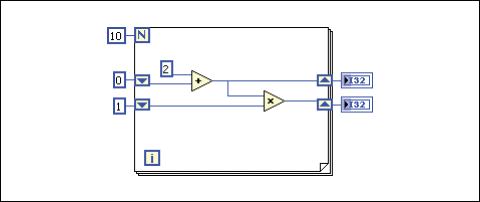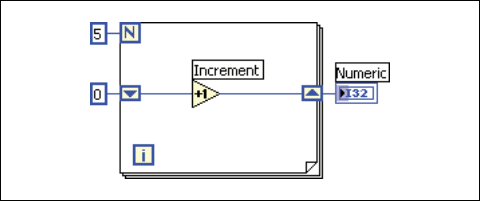Are Shift Registers Bad For Performance Labview
Included in the Section
- Shift Registers
- Initializing Shift Registers
- Stacked Shift Registers
When programming with loops, you lot often must access data from previous iterations of the loop in LabVIEW. For case, if you are acquiring ane slice of data in each iteration of a loop and must average every five pieces of data, you must retain the data from previous iterations of the loop.
Shift Registers

Use shift registers when y'all want to pass values from previous iterations through the loop to the next iteration. A shift register appears as a pair of terminals straight opposite each other on the vertical sides of the loop edge.
The terminal on the right side of the loop contains an upwardly pointer and stores data on the completion of an iteration. LabVIEW transfers the information connected to the correct side of the register to the next iteration. Subsequently the loop executes, the last on the right side of the loop returns the last value stored in the shift register.
Create a shift register past correct-clicking the left or right border of a loop and selecting Add Shift Register from the shortcut menu.
A shift annals transfers any data type and automatically changes to the data type of the outset object wired to the shift register. The data you wire to the terminals of each shift annals must be the same type.
You can add together more than one shift register to a loop. If you have multiple operations that use previous iteration values within your loop, employ multiple shift registers to shop the data values from those different processes in the construction, as shown in Figure 1.

Figure one. Using Multiple Shift Registers
Initializing Shift Registers
Initializing a shift register resets the value the shift register passes to the first iteration of the loop when the VI runs. Initialize a shift register by wiring a control or constant to the shift annals terminal on the left side of the loop, as shown in Figure 2.

Figure 2. Initialized Shift Register
In Effigy 2, the For Loop executes 5 times, incrementing the value the shift register carries by one each time. Later on five iterations of the For Loop, the shift register passes the last value, five, to the indicator and the VI quits. Each time you run the VI, the shift register begins with a value of 0. If you exercise non initialize the shift register, the loop uses the value written to the shift register when the loop last executed or, if the loop has never executed, the default value for the information type. Use an uninitialized shift register to preserve land information between subsequent executions of a VI.

Figure 3. Uninitialized Shift Annals
In Effigy three, the For Loop executes five times, incrementing the value the shift register carries by ane each time. The first time you run the 6, the shift register begins with a value of 0, which is the default value for a 32-bit integer. After five iterations of the For Loop, the shift register passes the final value, 5, to the indicator, and the VI quits. The next fourth dimension you run the Six, the shift annals begins with a value of 5, which was the concluding value from the previous execution. Afterward five iterations of the For Loop, the shift register passes the terminal value, 10, to the indicator. If you run the VI again, the shift register begins with a value of 10, and and then on. Uninitialized shift registers retain the value of the previous iteration until you close the Vi.
Stacked Shift Registers
With stacked shift registers, you can admission data from previous loop iterations. Stacked shift registers remember values from multiple previous iterations and carry those values to the next iterations. To create a stacked shift register, right-click the left terminal and select Add Element from the shortcut bill of fare.
Stacked shift registers tin occur only on the left side of the loop because the right concluding transfers the data generated from merely the electric current iteration to the next iteration.

Figure 4. Using Stacked Shift Registers
If y'all add another chemical element to the left terminal in the previous cake diagram, values from the terminal 2 iterations comport over to the side by side iteration, with the most recent iteration value stored in the top shift register. The bottom terminal stores the data passed to it from the previous iteration.
Source: https://www.ni.com/getting-started/labview-basics/shift-registers
Posted by: fosterrismustriog.blogspot.com


0 Response to "Are Shift Registers Bad For Performance Labview"
Post a Comment